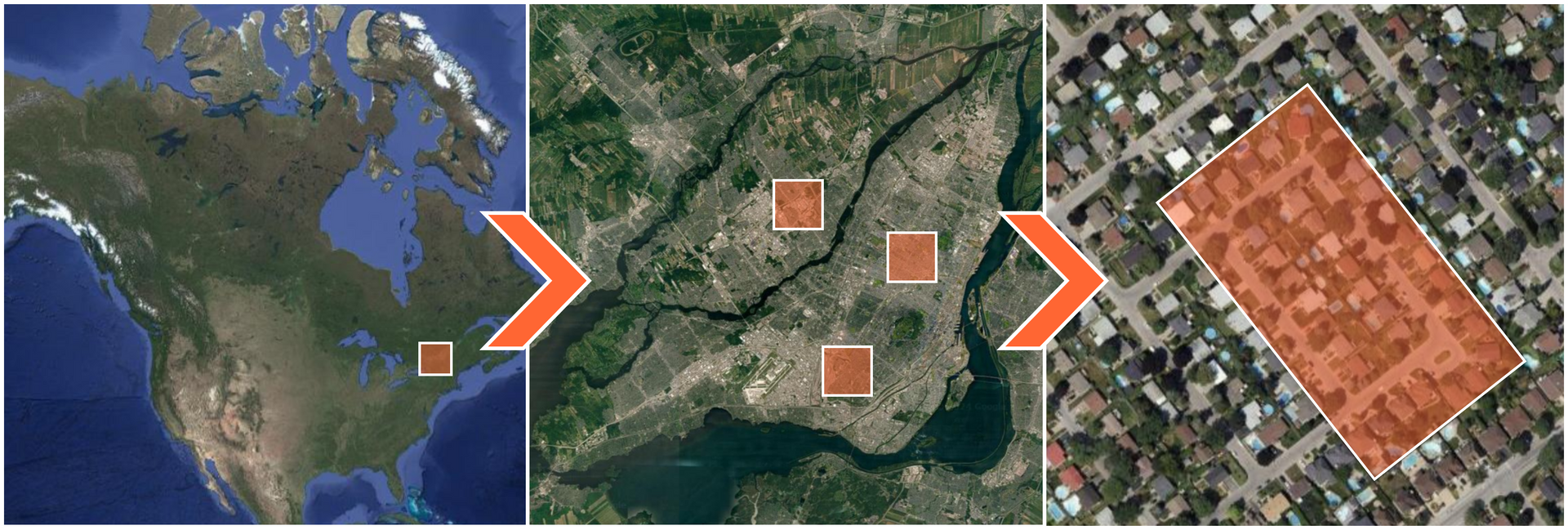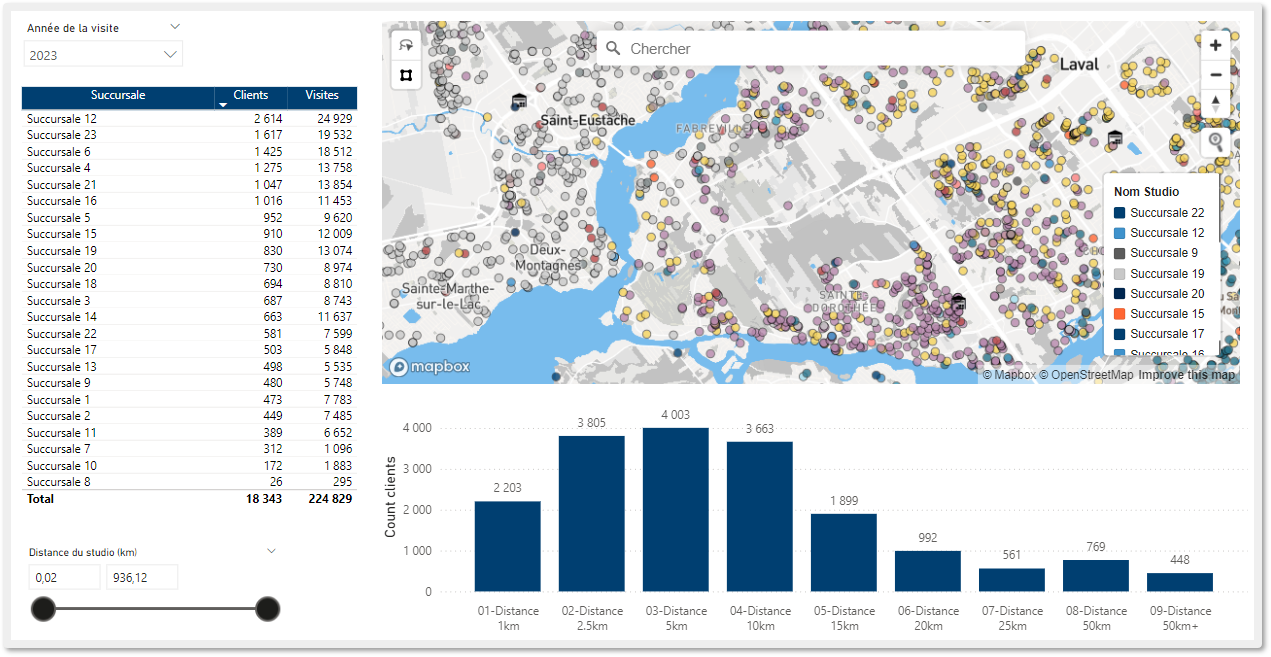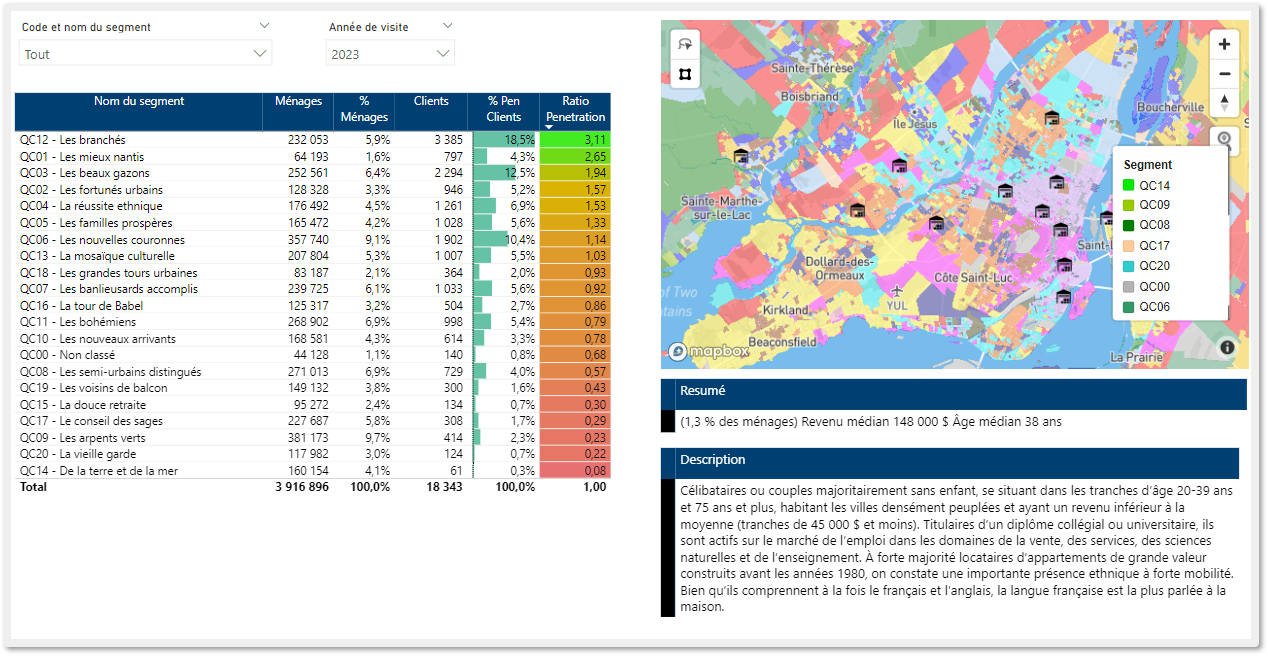Growth Plan
The key to your geographical growth
Obtain a detailed geographic growth plan, designed to propel your company's growth over the next few years. We carefully identify your geographical success factors and extrapolate them to the entire desired territory.
Whether your business is already well established or expanding, we guide you to promising environments. Not only will you be able to maximize your impact by strengthening your market share where you already have a presence, but you will also be able to seize untapped opportunities by expanding into new markets. Take the first step towards meaningful and sustainable geographic growth by partnering with us.
Growth Plan
The key to your geographical growth
Obtain a detailed geographic growth plan, designed to propel your company's growth over the next few years. We carefully identify your geographical success factors and extrapolate them to the entire desired territory.
Whether your business is already well established or expanding, we guide you to promising environments. Not only will you be able to maximize your impact by strengthening your market share where you already have a presence, but you will also be able to seize untapped opportunities by expanding into new markets. Take the first step towards meaningful and sustainable geographic growth by partnering with us.
Growth Plan
The key to your geographical growth
Obtain a detailed geographic growth plan, designed to propel your company's growth over the next few years. We carefully identify your geographical success factors and extrapolate them to the entire desired territory.
Whether your business is already well established or expanding, we guide you to promising environments. Not only will you be able to maximize your impact by strengthening your market share where you already have a presence, but you will also be able to seize untapped opportunities by expanding into new markets. Take the first step towards meaningful and sustainable geographic growth by partnering with us.
Sequence your growth opportunities
We quantify your market and potential customers within the 335,000 neighborhoods of North America, thanks to census data and our customized web extractions. We aggregate this data at the neighborhood, city, region, or custom geography specifically designed for your business, to identify the best opportunities to plan your growth strategy.
Obtain a precise snapshot of your market share at any geographical level, identify priority sectors to develop and potential customers to target. This prospecting universe will allow you to optimize your sales force by promoting balance between managing current accounts and prospecting.

Sequence your growth opportunities
We quantify your market and potential customers within the 335,000 neighborhoods of North America, thanks to census data and our customized web extractions. We aggregate this data at the neighborhood, city, region, or custom geography specifically designed for your business, to identify the best opportunities to plan your growth strategy.
Obtain a precise snapshot of your market share at any geographical level, identify priority sectors to develop and potential customers to target. This prospecting universe will allow you to optimize your sales force by promoting balance between managing current accounts and prospecting.

Monitor your progress dynamically
Follow your performance dynamically with our Power BI dashboard, which consolidates every analysis element and results in one place.
Discover this affordable deliverable that will transform your business approach. Our precise data fuels our analyses and offers you unprecedented insights, our intuitive maps facilitate dynamic information visualization, and our documented prospect lists are optimal for managing your development and prospecting tasks.
Each element of our offer is not just a tool, but a strategic lever that reduces risks and clarifies your vision. With our approach, strategy shapes itself, opening new horizons for you.
Monitor your progress dynamically
Follow your performance dynamically with our Power BI dashboard, which consolidates every analysis element and results in one place.
Discover this affordable deliverable that will transform your business approach. Our precise data fuels our analyses and offers you unprecedented insights, our intuitive maps facilitate dynamic information visualization, and our documented prospect lists are optimal for managing your development and prospecting tasks.
Each element of our offer is not just a tool, but a strategic lever that reduces risks and clarifies your vision. With our approach, strategy shapes itself, opening new horizons for you.
- Customer analysis
- Point of sale analysis
- Targeting potential customers
- Competitive analysis and traffic generators
- Performance analysis and local market shares
- Definition of the optimal network
- Distribution strategy
- Sales force optimization
- Geographic business strategy
- Acquisition of real estate assets
- Customer analysis
- Point of sale analysis
- Targeting potential customers
- Competitive analysis and traffic generators
- Performance analysis and local market shares
- Definition of the optimal network
- Distribution strategy
- Sales force optimization
- Geographic business strategy
- Acquisition of real estate assets

Slide title
Write your caption hereButton
Slide title
Write your caption hereButton
Slide title
Write your caption hereButton
Slide title
Write your caption hereButton
Slide title
Write your caption hereButton
Slide title
Write your caption hereButton

Slide title
Write your caption hereButton
Slide title
Write your caption hereButton
Slide title
Write your caption hereButton
Slide title
Write your caption hereButton
Slide title
Write your caption hereButton
Slide title
Write your caption hereButton
A flexible method applicable to both business or consumer focused strategies
The Indicia method offers a structural framework that adapts to both B2B and B2C dynamics; always providing you with a meticulously personalized growth plan tailored to your situation that will address your business questions and help you achieve your goals.
The type of clientele you deal with affects how our analyses are conducted and which factors need to be emphasized.
A flexible method applicable to both business or consumer focused strategies
The Indicia method offers a structural framework that adapts to both B2B and B2C dynamics; always providing you with a meticulously personalized growth plan tailored to your situation that will address your business questions and help you achieve your goals.
The type of clientele you deal with affects how our analyses are conducted and which factors need to be emphasized.
B2B Universe

You are engaged in the sale of goods, services, or business-to-business solutions, primarily in sectors such as manufacturing and distribution. Your sales volumes are high, your sales cycles extended, and your negotiations complex. You aim to establish long-lasting and beneficial relationships with your partners to foster growth and to favor the growth and efficiency of your distribution network.
- How can we increase our market share and accounts?
- How can we find quality prospects?
- How can we identify the right customers?
- How can we better serve your customers?
- Where should our distribution centers be located?
- How can we optimize the performance of our salespeople?
- How many distributors or manufacturing agents are required to maximize your market coverage?
1. Identification of Promising Segments
We identify the most important customer segments for you using business penetration matrices by industrial sector. The segments with the highest rate of customers and sales are retained as part of your “core market”.
2. Creation of the Prospecting Universe
Companies that are retained as part of your “core market” are extracted from the web by our research team, which ensures that each point is individually documented and relevant characteristics are noted.
The prospecting universe can contain several thousand lines of unique, bannered, or independent companies, as well as their relevant characteristics for analysis (occupied area, type of building, etc.).
Your clients are then associated with this universe to determine which companies are already doing business with you, how much they spend, and who remains as a prospect.
3. Market Definition and Allocation
Your market is then defined based on a clever mix of census data, reliable third-party sources, and statistical extrapolations, and allocated to each company in the geographical area under study.
Each business is assigned a potential sales value based on its segment, type of environment, or other relevant characteristics.
4. Performance and Market Share
By summarizing all the companies and their potential sales, we are able to quantify the market and the number of available accounts, regardless of the desired geographical scale.
This method forms the basis of our dissemination tools, which allow you to track your performance in terms of market share, account share, and portfolio share across any city, region, or province.
5. Target Definition
Your overall performance is then analyzed to determine realistic performance targets, providing all the necessary information to achieve them.
By visualizing the priority areas, you will be able to see which current and potential accounts are located there, allowing you to send salespeople or relocate a warehouse to better serve them.
B2C Universe

You sell your products or services directly to consumers, whether online or in-store. As a B2C company, you focus on creating engaging shopping experiences and building customer loyalty to drive your sales. Your goal is to strengthen your presence among consumers and expand your network.
- How to identify key segments ?
- How to determine their location ?
- What is the size of your market ?
- What is your fair market share ?
- Who are your direct competitors and how do they impact you ?
- What is the size of your trade areaa ?
- What is the optimal sequence for opening your new points of sale ?
1. Identification of Promising Segments
We identify the most important customer segments for you using customer penetration matrices by STRATUS code. These segments group people with similar socio-demographic characteristics and allow us to create a profile of your target customers.
2. Definition of Commercial Zones
We determine your commercial zones by analyzing the origin of your customers based on distance traveled. This geographical analysis allows us not only to identify strategic locations for new retail or distribution points but also to quantify the potential of each zone. By evaluating the number of households and their demographic profile, we can estimate the market size and purchasing power in each zone.
The definition of trade areas will also allow you to maximize your visibility and impact on the market, while optimizing your resources and strengthening your competitive position.
3. Definition and Allocation of the Market
Your market is then defined using a clever mix of census data, reliable third-party sources, and statistical extrapolations; and allocated to each micro-neighborhood within the geographical area under study.
Each neighborhood is assigned a fraction of the market based on the number of households it contains, weighted by the performance of its primary STRATUS segment.
4. Definition of Success Rules
By combining all the previous information, we establish your geographical success criteria related to opening a new location.
These criteria take into account the number of households, available market, and other relevant characteristics such as competition threshold, day vs. night population, etc.
5. Ranking of Opportunities
The success rules are then applied to the entire geographical area under study, dividing it into territories capable of supporting a store.
These territories are ranked according to their probability for success, allowing you to develop your network by prioritizing the locations that are most likely to perform well.

B2B Universe
You are engaged in the sale of goods, services, or business-to-business solutions, primarily in sectors such as manufacturing and distribution. Your sales volumes are high, your sales cycles extended, and your negotiations complex. You aim to establish long-lasting and beneficial relationships with your partners to foster growth and to favor the growth and efficiency of your distribution network.
- How to increase your market share and active accounts ?
- How to find quality prospects ?
- How to identify the right sectors to develop ?
- How to better serve your customers ?
- Where to locate your distribution centers ?
- How to optimize the performance of your salespeople ?
- How many distributors or manufacturing agents are required to maximize your market coverage ?
1. Identification of Promising Segments
We identify the most important customer segments for you using business penetration matrices by industrial sector. The segments with the highest rate of customers and sales are retained as part of your “core market”.
2. Creation of the Prospecting Universe
Companies that are retained as part of your “core market” are extracted from the web by our research team, which ensures that each point is individually documented and relevant characteristics are noted.
The prospecting universe can contain several thousand lines of unique, bannered, or independent companies, as well as their relevant characteristics for analysis (occupied area, type of building, etc.).
Your clients are then associated with this universe to determine which companies are already doing business with you, how much they spend, and who remains as a prospect.
3. Market Definition and Allocation
Your market is then defined based on a clever mix of census data, reliable third-party sources, and statistical extrapolations, and allocated to each company in the geographical area under study.
Each business is assigned a potential sales value based on its segment, type of environment, or other relevant characteristics.
4. Performance and Market Share
By summarizing all the companies and their potential sales, we are able to quantify the market and the number of available accounts, regardless of the desired geographical scale.
This method forms the basis of our dissemination tools, which allow you to track your performance in terms of market share, account share, and portfolio share across any city, region, or province.
5. Target Definition
Your overall performance is then analyzed to determine realistic performance targets, providing all the necessary information to achieve them.
By visualizing the priority areas, you will be able to see which current and potential accounts are located there, allowing you to send salespeople or relocate a warehouse to better serve them.

B2B Universe
You are engaged in the sale of goods, services, or business-to-business solutions, primarily in sectors such as manufacturing and distribution. Your sales volumes are high, your sales cycles extended, and your negotiations complex. You aim to establish long-lasting and beneficial relationships with your partners to foster growth and to favor the growth and efficiency of your distribution network.
- How to increase your market share and active accounts ?
- How to find quality prospects ?
- How to identify the right sectors to develop ?
- How to better serve your customers ?
- Where to locate your distribution centers ?
- How to optimize the performance of your salespeople ?
- How many distributors or manufacturing agents are required to maximize your market coverage ?
1. Identification of Promising Segments
We identify the most important customer segments for you using business penetration matrices by industrial sector. The segments with the highest rate of customers and sales are retained as part of your “core market”.
2. Creation of the Prospecting Universe
Companies that are retained as part of your “core market” are extracted from the web by our research team, which ensures that each point is individually documented and relevant characteristics are noted.
The prospecting universe can contain several thousand lines of unique, bannered, or independent companies, as well as their relevant characteristics for analysis (occupied area, type of building, etc.).
Your clients are then associated with this universe to determine which companies are already doing business with you, how much they spend, and who remains as a prospect.
3. Market Definition and Allocation
Your market is then defined based on a clever mix of census data, reliable third-party sources, and statistical extrapolations, and allocated to each company in the geographical area under study.
Each business is assigned a potential sales value based on its segment, type of environment, or other relevant characteristics.
4. Performance and Market Share
By summarizing all the companies and their potential sales, we are able to quantify the market and the number of available accounts, regardless of the desired geographical scale.
This method forms the basis of our dissemination tools, which allow you to track your performance in terms of market share, account share, and portfolio share across any city, region, or province.
5. Target Definition
Your overall performance is then analyzed to determine realistic performance targets, providing all the necessary information to achieve them.
By visualizing the priority areas, you will be able to see which current and potential accounts are located there, allowing you to send salespeople or relocate a warehouse to better serve them.

B2C Universe
You sell your products or services directly to consumers, whether online or in-store. As a B2C company, you focus on creating engaging shopping experiences and building customer loyalty to drive your sales. Your goal is to strengthen your presence among consumers and expand your network.
- How to identify key segments ?
- How to determine their location ?
- What is the size of your market ?
- What is your fair market share ?
- Who are your direct competitors and how do they impact you ?
- What is the size of your trade areaa ?
- What is the optimal sequence for opening your new points of sale ?
1. Identification of Promising Segments
We identify the most important customer segments for you using customer penetration matrices by STRATUS code. These segments group people with similar socio-demographic characteristics and allow us to create a profile of your target customers.
2. Definition of Commercial Zones
We determine your commercial zones by analyzing the origin of your customers based on distance traveled. This geographical analysis allows us not only to identify strategic locations for new retail or distribution points but also to quantify the potential of each zone. By evaluating the number of households and their demographic profile, we can estimate the market size and purchasing power in each zone.
The definition of trade areas will also allow you to maximize your visibility and impact on the market, while optimizing your resources and strengthening your competitive position.
3. Definition and Allocation of the Market
Your market is then defined using a clever mix of census data, reliable third-party sources, and statistical extrapolations; and allocated to each micro-neighborhood within the geographical area under study.
Each neighborhood is assigned a fraction of the market based on the number of households it contains, weighted by the performance of its primary STRATUS segment.
4. Definition of Success Rules
By combining all the previous information, we establish your geographical success criteria related to opening a new location.
These criteria take into account the number of households, available market, and other relevant characteristics such as competition threshold, day vs. night population, etc.
5. Ranking of Opportunities
The success rules are then applied to the entire geographical area under study, dividing it into territories capable of supporting a store.
These territories are ranked according to their probability for success, allowing you to develop your network by prioritizing the locations that are most likely to perform well.

B2C Universe
You sell your products or services directly to consumers, whether online or in-store. As a B2C company, you focus on creating engaging shopping experiences and building customer loyalty to drive your sales. Your goal is to strengthen your presence among consumers and expand your network.
- How to identify key segments ?
- How to determine their location ?
- What is the size of your market ?
- What is your fair market share ?
- Who are your direct competitors and how do they impact you ?
- What is the size of your trade areaa ?
- What is the optimal sequence for opening your new points of sale ?
1. Identification of Promising Segments
We identify the most important customer segments for you using customer penetration matrices by STRATUS code. These segments group people with similar socio-demographic characteristics and allow us to create a profile of your target customers.
2. Definition of Commercial Zones
We determine your commercial zones by analyzing the origin of your customers based on distance traveled. This geographical analysis allows us not only to identify strategic locations for new retail or distribution points but also to quantify the potential of each zone. By evaluating the number of households and their demographic profile, we can estimate the market size and purchasing power in each zone.
The definition of trade areas will also allow you to maximize your visibility and impact on the market, while optimizing your resources and strengthening your competitive position.
3. Definition and Allocation of the Market
Your market is then defined using a clever mix of census data, reliable third-party sources, and statistical extrapolations; and allocated to each micro-neighborhood within the geographical area under study.
Each neighborhood is assigned a fraction of the market based on the number of households it contains, weighted by the performance of its primary STRATUS segment.
4. Definition of Success Rules
By combining all the previous information, we establish your geographical success criteria related to opening a new location.
These criteria take into account the number of households, available market, and other relevant characteristics such as competition threshold, day vs. night population, etc.
5. Ranking of Opportunities
The success rules are then applied to the entire geographical area under study, dividing it into territories capable of supporting a store.
These territories are ranked according to their probability for success, allowing you to develop your network by prioritizing the locations that are most likely to perform well.




